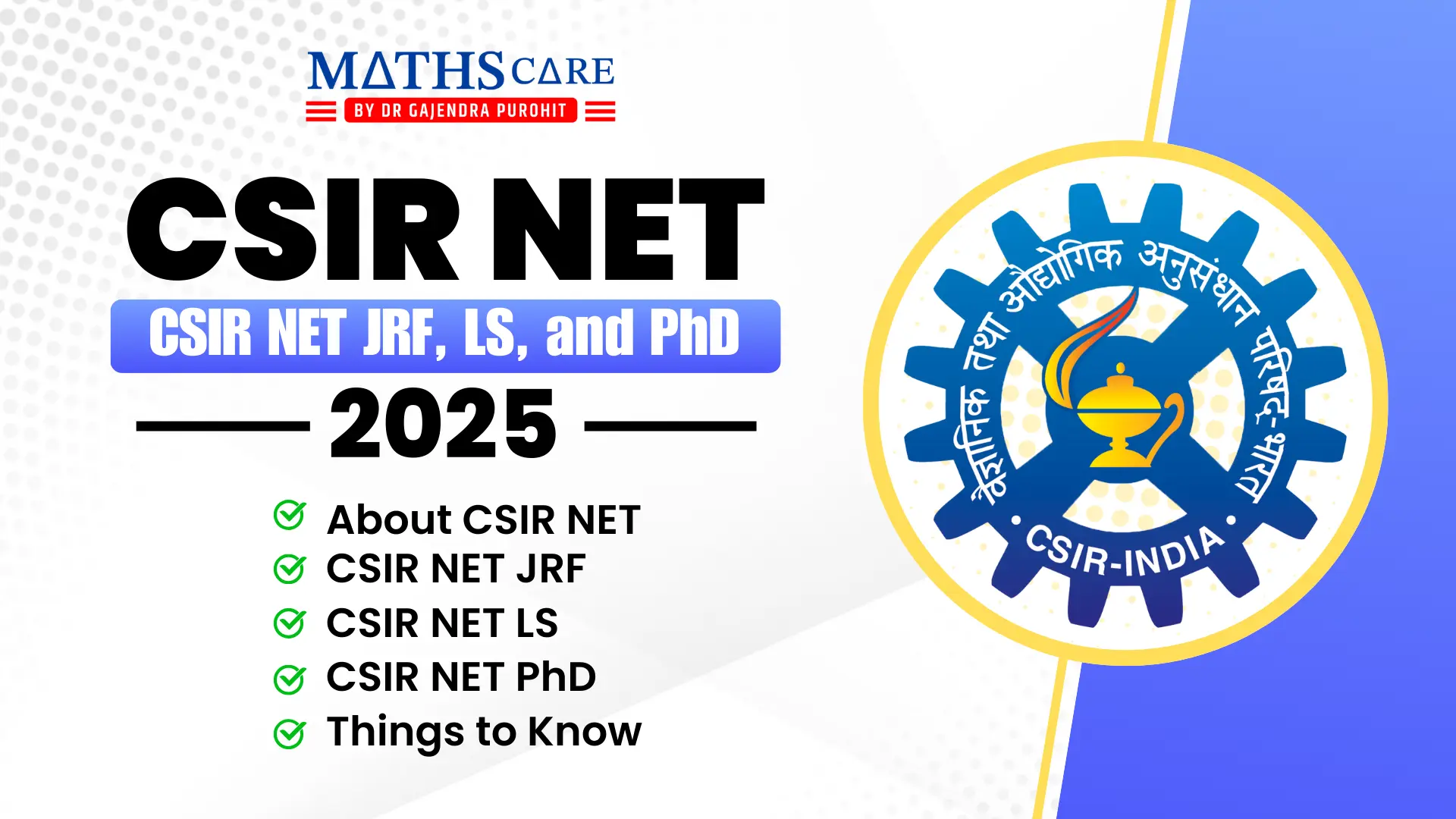CSIR NET JRF, LS, and PhD
CSIR NET (Council of Scientific and Industrial Research National Eligibility Test): The CSIR NET (Council of Scientific & Industrial Research National Eligibility Test) is one of India’s most prestigious exams, designed to determine eligibility for Junior Research Fellowship (JRF), Lectureship (LS), and Ph.D. admissions. Conducted by the National Testing Agency (NTA), this examination is crucial for candidates aspiring to pursue research or become professors in Indian universities and colleges. The test ensures a standardized assessment of scientific aptitude and subject knowledge, allowing deserving candidates to qualify for academic and research positions in institutions across the country. This guide provides an in-depth overview of the CSIR NET, its eligibility, exam structure, application process, and career opportunities.

About CSIR NET
The Joint CSIR-UGC NET is an exam conducted to select candidates for JRF, LS, and Ph.D. admissions in Indian universities and research institutions. The test is conducted in subjects related to science and technology, including Mathematical Sciences, Physical Sciences, Chemical Sciences, Life Sciences, and Earth Sciences. The primary objective of the exam is to identify individuals with research potential and teaching capabilities, thereby enhancing the quality of higher education and scientific research in India.
CSIR and University Grants Commission (UGC) jointly offer fellowships and grants for research, enabling students to undertake projects under expert guidance at prestigious institutions such as IITs, IISc, CSIR Labs, and other research centers.
Eligibility Criteria for CSIR NET
To apply for CSIR NET JRF, LS, or Ph.D., candidates must meet the following eligibility conditions:
Educational Qualification: Candidates must have a Master’s degree (M.Sc.) or equivalent in a relevant science subject with at least 55% marks (50% for SC/ST/PwD candidates).
Age Limit:
JRF: Maximum 28 years (relaxation of up to 5 years for reserved categories and women applicants).
Lectureship & Ph.D.: No age limit.
Appearing Candidates: Students in their final year of a Master’s program are also eligible to apply, provided they meet the qualifying criteria upon result declaration.
Nationality: The exam is open to Indian citizens only.
Exam Pattern
The CSIR NET exam is conducted in Computer-Based Test (CBT) mode and consists of a single paper divided into three sections (A, B, and C):
Section A (General Aptitude) – Tests logical reasoning, quantitative ability, and graphical analysis. It carries 20 questions, of which 15 need to be attempted.
Section B (Subject-Specific Questions) – Consists of multiple-choice questions (MCQs) covering fundamental concepts of the chosen subject.
Section C (Higher-Order Questions) – Contains analytical and application-based questions requiring in-depth understanding and problem-solving skills.
The marking scheme varies based on the subject, and negative marking is applicable for incorrect responses.
Registration and Application Process
The application process for CSIR NET is conducted online through the official NTA portal. Here are the key steps to apply:
Visit the Official Website: Go to https://csirnet.nta.ac.in/ and navigate to the application section.
Register: Create an account using a valid email ID and phone number.
Fill in Details: Enter personal information, academic qualifications, and subject preferences.
Upload Documents: Provide scanned copies of photograph, signature, and relevant certificates.
Pay the Fee: Submit the application fee via online banking, credit/debit card, or UPI.
Print Confirmation: Download and keep a copy of the application form for future reference.
Admit Card and Examination Instructions
The CSIR NET Admit Card is released two weeks before the exam date.
Candidates must download and print the admit card from the official website.
The exam instructions prohibit carrying electronic gadgets, books, or unauthorized materials inside the examination hall.
Candidates should carry valid ID proof (Aadhar card, PAN card, passport, or voter ID) along with the admit card.
CSIR NET JRF vs CSIR NET LS vs CSIR NET PhD
Understanding the distinctions between CSIR NET JRF, LS, and PhD is crucial for candidates planning their future academic and professional journeys. Each category serves a different purpose and comes with its own set of benefits and requirements.
CSIR NET JRF (Junior Research Fellowship): This fellowship provides financial assistance to candidates aiming to pursue research. JRF-qualified candidates receive a monthly stipend for up to five years, allowing them to conduct research under the supervision of an accredited faculty member. This fellowship also opens doors for Ph.D. admissions in prestigious institutions. Securing a JRF qualification not only ensures funding but also enhances the research credentials of the candidate, making them more competitive in their field.
CSIR NET LS (Lectureship Eligibility): Qualifying for the LS category makes candidates eligible for Assistant Professor positions in colleges and universities across India. Unlike JRF candidates, LS qualifiers do not receive direct financial support for research but can apply for various teaching and academic roles. In many cases, LS-qualified individuals can still pursue Ph.D. programs, but they may need to seek external funding sources or institutional support. This qualification is highly valued for those aspiring to work in academia and contribute to the education sector.
CSIR NET PhD Admissions: Many top research institutions, including IISc, IITs, NITs, and CSIR labs, prefer CSIR NET-qualified candidates for Ph.D. admissions. Although candidates who qualify for JRF receive direct funding for their research, LS-qualified individuals and other CSIR NET aspirants can still apply for Ph.D. programs through alternative funding sources. Ph.D. admission through CSIR NET is considered prestigious and significantly enhances the career prospects of researchers, granting them opportunities in both academia and industry.
By understanding the key differences between these categories, candidates can better strategize their preparation and career plans, ensuring they align with their long-term goals.
Understanding the differences between CSIR NET JRF, LS, and PhD is essential for candidates planning their career paths:
CSIR NET JRF (Junior Research Fellowship): This is a fellowship program that provides financial assistance to candidates pursuing Ph.D. programs. JRF-qualified candidates receive a monthly stipend for up to five years and are required to conduct research under the guidance of a supervisor in recognized institutions.
CSIR NET LS (Lectureship Eligibility): Candidates qualifying for LS can apply for assistant professor positions in Indian universities and colleges. While they are not eligible for JRF funding, they can pursue Ph.D. programs by securing other research grants or self-funding.
CSIR NET PhD Admissions: Many institutions prefer CSIR NET-qualified candidates for Ph.D. admissions. Qualifying CSIR NET enhances a candidate’s academic profile and increases the chances of securing research opportunities in reputed universities and institutes.
Career Opportunities After Qualifying CSIR NET
Clearing the CSIR NET exam opens multiple career avenues in academia and research:
Junior Research Fellowship (JRF): Enables candidates to pursue Ph.D. programs in recognized institutions with monthly financial support.
Lectureship (LS): Qualifies candidates for teaching positions at universities and colleges.
Ph.D. Admissions: Many research institutions prefer CSIR NET-qualified candidates for their Ph.D. programs.
Corporate and R&D Jobs: Industries and research organizations hire NET-qualified professionals for scientific research and technological advancements.
Government Research Institutes: Positions in ISRO, DRDO, CSIR labs, and other governmental organizations.
Conclusion
The CSIR NET exam is an essential step for those aiming for a career in research and academia. Qualifying for JRF, LS, or Ph.D. through CSIR NET ensures strong academic credentials, funding opportunities, and enhanced job prospects in prestigious institutions. With a structured preparation strategy and thorough understanding of the syllabus, aspirants can excel in the examination and secure promising roles in the field of science and education. Stay updated with official notifications, and best of luck to all aspirants!
CSIR NET FAQS
To pass the CSIR NET 2024 Exam, candidates must score at least 33 percent in the general, EWS, and OBC categories and 25 percent in the SC, ST, and PwD categories. The CSIR NET 2024 Dec result will be released on the official website at csirnet.nta.ac.in.
In India, holding a PhD isn’t just a distinction; it’s a formidable advantage. With a staggering below 1% unemployment rate for PhD holders, as reported by Gururo, compared to the national average of 7%, the demand for highly skilled individuals is unmistakable.
Candidates applying for the Junior Research Fellowship (JRF) should not be more than 30 years of age as on the first day of the month i.e., 1/06/2024 in which the UGC NET 2024 exam concludes, that is, June.
The CSIR NET Lectureship pay scale lies between INR 37000 – 67000 per month on average. This may increase up to INR 1,33,000 – 1,41,000 with promotions and experience.
CSIR prescribes CSIR NET Eligibility Criteria 2024 along with the notification in terms of age limit, educational qualification and nationality. CSIR JRF Age Limit is 28 years. Candidates must hold an MSc/BE/Integrated BS-MS/BS four-year degree/BPharma/BTech/MBBS with 55 per cent.
BEST OFFERING COURSES FOR YOU
BEST BOOKS FOR IIT JAM/ CSIR-NET
BUY BOOKS ON OUR APP
RECENT POSTS

CSIR NET Score Card Dates (Tentative)

CSIR NET Answer Key Dates (Expected)

CSIR NET Syllabus Mathematics 2025








